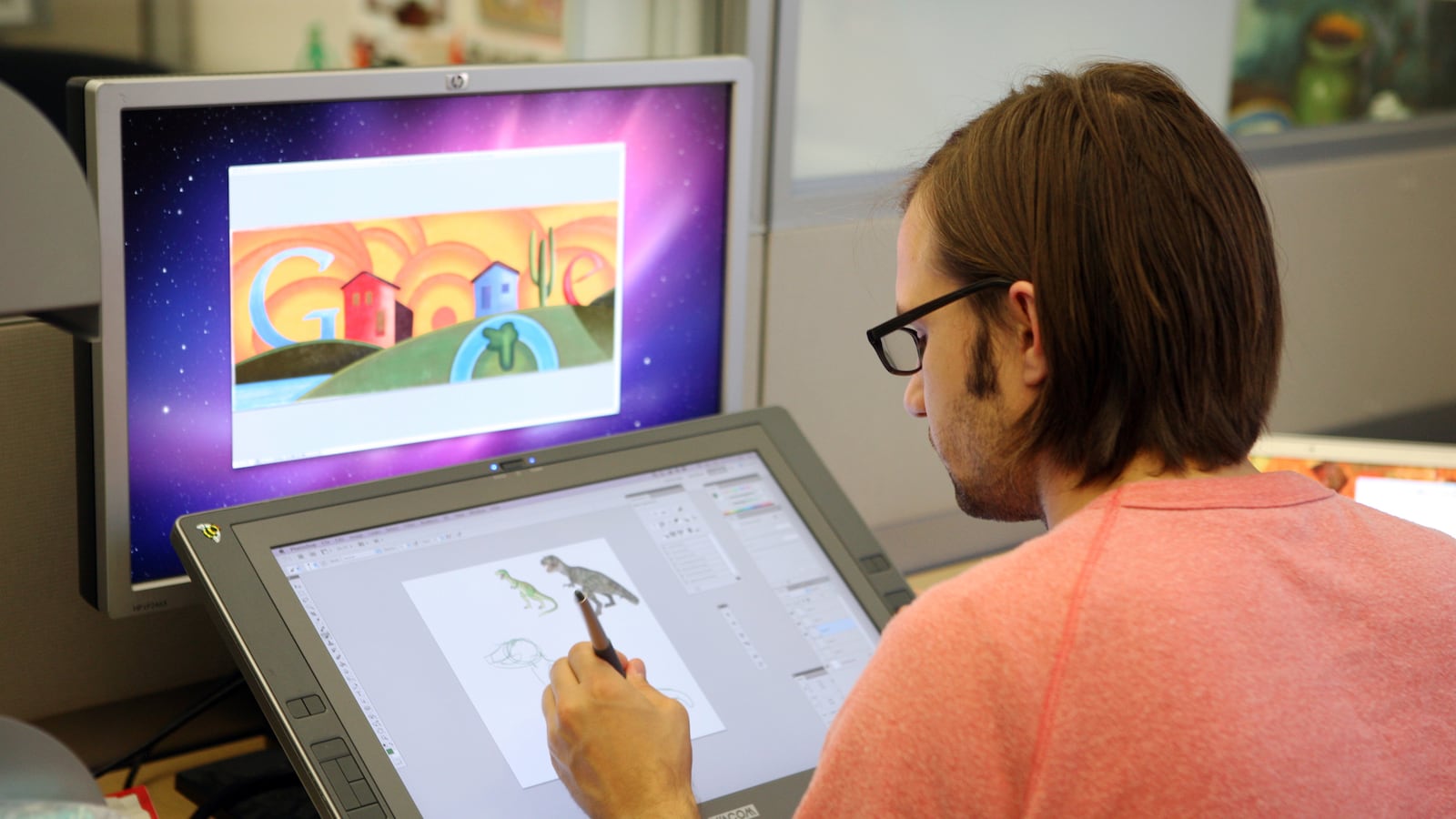Ryan Germick is the leader of Google’s Doodle team—the people who put together the just-for-one-day images and animations that pop up on Google’s homepage every week or so. His co-worker Aaron Koblin is the creative director of Google’s Data Arts team, who are responsible for chromeexperiments.com. At a famously results-oriented company, they’re the people whose full-time job it is to play around with new technology and see what happens. The Daily Beast spoke to the two of them at Moogfest, in Asheville, NC.

How often does Google try to run a Doodle on its home page?
RYAN GERMICK: There’s no magic formula. Serendipity is one of our main tools. It’s the element of surprise—“no one’s expecting the Doodle Inquisition!” In the U.S., I’d say there’s roughly one a week or so, but the vast majority of what we do is outside the U.S. There’s almost one a day, on average, if you put them all together. We want it to be an authentic introduction to something that’s worth paying attention to.
The Moog Doodle [in 2012] was a no-brainer. Bob Moog was a patron saint of the nerdy arts; he’s somebody that Google would probably be trying to be actively trying to recruit! His curiosity and drive to create tools for people to create art through science is something there’s a deep love and respect for inside of Google. One of the professional highlights of my entire career was when I was on the phone with Michelle, his daughter, and we were trying to set up a Google Hangout so I could share our progress with her on the Moog Doodle, and she heard me absentmindedly playing with the thing in the background, but she said, “That sounds like my childhood.” That was so amazing.
Aaron, what does the Data Arts team work on?
AARON KOBLIN: We do a lot of experiments with HTML5, Javascript and WebGL. Our group’s mandate or function is creating showcases for Google products and services. We run chromexperiments.com, we create a lot of demo hacks, art projects, and other things. My background’s in data visualization and storytelling; we’ve done a number of music videos, including Arcade Fire’s “Reflektor.”
How does music get integrated into what you do?
KOBLIN: To be honest, music wasn’t necessarily part of our mandate or core objective, but I’ve just personally always been enthralled with music. I worked with a music video director named James Frost, prior to coming to Google—we did a music video for Radiohead’s “House of Cards.” That was one of my earlier forays into the world of videos, and I got really excited by the format.
GERMICK: It’s an exciting thing to be making things on the Internet, because some of the things that are happening in the browser space make audio capabilities a reality. We’ve really only done a handful of Doodles that are audio-centric, but it’s been a great pleasure to allow people to both consume and create great pieces of music—or just weird sound effects.
Do you have any kind of metric for whether what you're doing is working or not?
GERMICK: It’s weird, because every one’s different. We do look at how long people play with them—the Moog Doodle had, I think, 54 million songs created. It’s a little different from a product like Google Search, where they’ll test things like—if you shift this over three pixels, does that mean people click on the first result more? Google’s very data-driven, and decisions are extremely rational; we’re sort of the exception to that rule. The first Doodle was before Google was even incorporated, in 1998—the Burning Man logo. Before they even filed the paperwork to make Google a legit company. I think that speaks volumes about the sort of irreverence that’s at the heart of the branding aspect of Google.
What's the Doodle people have played with longest?
GERMICK: The Doctor Who Doodle had a lot of people playing with it for a long time, partly because when you die your time is added to your score. We did a Doodle in September for Google's 15th birthday; it was designed to be the silliest, simplest game you could possibly make, and we thought it would be appropriate for a quinceañera to have a piñata. It was really a one-click game...and we saw more than half a billion plays in one day. People really liked that game.
We also do feel a responsibility to be authentic and educational; every Doodle resolves to a search result so you can learn more. Part of the exciting thing is that it becomes part of the discussion for the day. It was so great to see Robert Moog trending on Twitter.
Which Doodles get people to click through and look at search results most?
GERMICK: It's hard to know whether people are clicking through because they’re curious or not. Sometimes it might be because it’s confusing. Or it might be an interesting image that they felt compelled to click on. One thing that’s really exciting is when we can put something forward that's commonplace but that people don’t think about. We did a Doodle for the man who invented the modern zipper... it’s something we use every day, but... it really shined light on something familiar.
How have you seen Google's design aesthetic change?
GERMICK: I think it was Sergei [Brin]’s quote, when asked why the Google homepage was so simple: “I don’t do HTML.” If you looked at the Web in 1998, at Lycos and Altavista and Yahoo, the idea was searching through directory links on the home page. Google has always had this idea of function and, almost, minimalism, but I think in the last few years, design has been treated as a first-class citizen. Especially as devices become more personal and you carry them with you all the time and identify with them, the aesthetic is more important.
KOBLIN: I would agree. I think there's been a cultural shift to making design a serious priority. It’s always been very engineering-oriented, but I think we’ve seen massive change in the last six years in terms of the conversations that are being had: that design needs to be a priority, and user experience really matters.
GERMICK: “Focus on the user” used to be defined as “Be as fast as possible, give them exactly what they want”...and while that’s certainly still a key value, one of the biggest technical changes Google’s made in its entire history is something you probably don’t even notice, which is Google Instant. When you go to the page and type, the search result appears. That was a massive technological design code shift, and it was really driven by user experience. Even the things we’re working on that are a little more fun are also part of the user experience—not just having your information needs met, but your curiosity and your need for entertainment.
More broadly, what do you think is the state of Google as a company right now?
GERMICK: The mission of the search world is to have this perfect assistant, and that becomes extremely powerful when multiplied by the fact that we all have this device in our pockets. It’s one thing to go to your desktop or laptop and type something in; it's another thing where anything you want to get done, you can just speak it. I can see Google becoming more and more helpful—your buddy who’s with you on the go. There’s sometimes talk inside of Google about “Google scale”: solving problems that need solving in a way only Google can do it.
Ryan, you’re famously a huge Prince fan. Have you thought about doing a Prince Doodle?
GERMICK: My team jokes about it! Currently we don’t do Doodles for living people, but I could easily be swayed.






